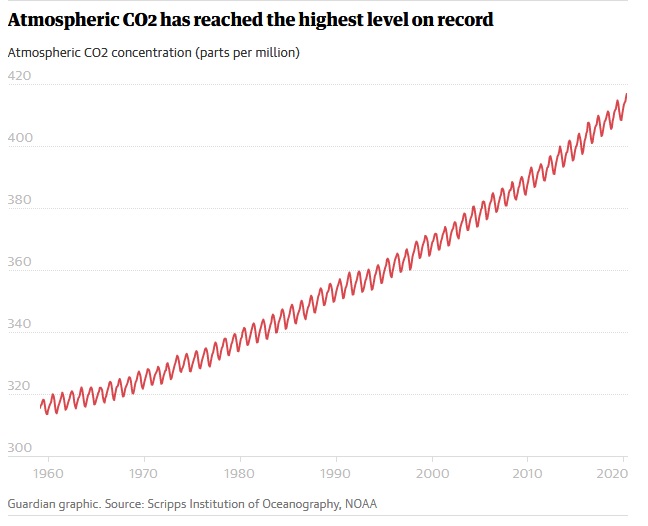Global heating: best and worst case scenarios less likely than thought

Doomsayers and hopemongers alike may need to revise their climate predictions after a study that almost rules out the most optimistic forecasts for global heating while downplaying the likelihood of worst-case scenarios.
The international team of scientists involved in the research say they have narrowed the range of probable climate outcomes, which reduces the uncertainty that has long plagued public debate about this field.
Their increased confidence about the sensitivity of the climate should ease the job of policymakers and diminish the scope for scepticism but it is far from reassuring for the future of the planet.
“The main message is that unfortunately we can’t expect that luck will save us from climate change,” Reto Knutti, professor of climate physics at ETH Zurich’s Institute for Atmospheric and Climate Science.
“The good thing is that we’ve somewhat narrowed the range of future long-term warming, the bad thing is that we can no longer hope or claim that the problem will just magically go away.”
Until now, the United Nations intergovernmental panel on climate change has estimated a doubling of atmospheric carbon dioxide from its pre-industrial level of about 280 parts per million has a 66% chance of heating the planet by between 1.5C to 4.5C. In May, atmospheric CO2 reached 417ppm, and is rising by about 2.5ppm per year.

Optimists could seize on the lower number to say no action was necessary. Pessimists could point to the higher figure to warn apocalypse was nigh.
The study, published in Reviews of Geophysics, shrinks that 66%-likely range of climate sensitivity to between 2.6C and 3.9C, or slightly wider if more uncertainties are included. This smaller band is still dangerously high, which means there is no room for complacency, but the most dire predictions are now considered less probable.
“It is moderately good news. It reduces the likelihood of some of the catastrophically high estimates. If we were planning for the worst, the worst has become less likely,” said one of the authors, Zeke Hausfather, of the Energy and Resources Group at University of California Berkeley. “But fundamentally, it means we must do more to limit climate change. We are not anywhere near on track to do that.”
Climate sensitivity measures the susceptibility of Earth’s climate to human influence. It has been considered the holy grail of climate science since the first 1.5C to 4.5C estimate in 1979. Numerous papers have been published on the subject, but that range has barely changed until now.
The latest, more precise study is likely to be the most influential yet because it is written by more than a dozen experts and draws upon the widest range of evidence, including observed physical processes, historical climate data, and records from the ice age.
The lead author of the study, Prof Steve Sherwood of the Climate Change Research Centre at the University of New South Wales, said understanding the potential range of climate sensitivity was crucial.
He said: “All the other impacts of climate change scale with climate sensitivity. The bigger the number is, the bigger the global temperature rise and the bigger all the other impacts.”
Sherwood said the study had effectively ruled out climate sensitivity being below 2.5C, but the higher end of the temperature ranges were harder to be confident about.
“If climate sensitivity is at the higher end, then you have almost lost any chance of meeting the Paris agreement and you would need to go into overdrive to avoid catastrophe.”
Gabi Hegerl, a professor at the University of Edinburgh who has been involved in past studies of climate sensitivity, said the latest papers went further than any before in bringing together different sets of evidence. Some help to rule out higher estimates, others lower.
“They tell us more together than they do individually. We can never completely eradicate uncertainty, but this is as rigorous as we can be,” she said. “Climate sensitivity is a theoretical concept but it narrows our decision space. What actually happens is up to our actions. In some way, I hope we never learn exactly who is right. I don’t want to go up to warming we expect from doubled CO2.”
This confluence of sources has allowed scientists to estimate with a 90% level of probability that climate sensitivity is between 2.3C and 4.7C. The most likely level of climate sensitivity has nudged slightly above 3C. Hausfather says a figure below 2C is extremely unlikely. Above 5C remains possible, though the study lowers that likelihood to 10%.
Earlier this year, a handful of climate models, including some of the world’s most advanced, suggested climate sensitivity could be above 5C, prompting alarm.
These high figures were not included in the this week’s study, but many climate scientists regard the recent higher numbers as outliers that should not be taken out of the broader context.
“Don’t panic!”, Gavin Schmidt, the director of the Nasa Goddard Institute for Space Studies in New York, tweeted earlier this year with a link to a blogpost that noted: “Claims that climate sensitivity is much higher, or that worst cases scenarios need to be revised upwards, are premature.“






